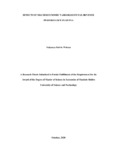| dc.description.abstract | For any government to effectively carry out its primary function and other subsidiary functions, it requires adequate funding. Taxation generates public funds to governments through structured approaches. The amount of tax revenue realized or expected by any state is determined and influenced by various economic factors ranging from micro to macro-economic. In Kenya, tax revenues have, for quite some time, remained low relative to the effort and tax policies in place. This study examined the effects of macroeconomic variables on tax revenue performance in Kenyausingannual time series data of ten years for the period 2008 to 2018,to estimate a linear model of tax revenue performance and the selected macro-economic factors. The period is extensive enough to give accurate results. The study adopted a correlation research design which is a non-experimental research design technique that helps researchers establish a relationship between two closely connected variables. Secondary data from the Central Bank of Kenya, Kenya National Bureau of Statistics (KNBS),Kenya Revenue Authority (KRA) and World Bank were Collected and presented using tables and figures. The study carried out pre-estimation tests so as to validate the results. Unit Root Tests was done to detect for stationarity using Augmented Dickey Fuller (ADF) test, Cointegration was done to test for long run relationship between the dependent variable and the independent or predictor variables was done using Engle-Granger test. Multicollinearity test was done to find out if the predictor variables are highly correlated using Vector Integrating Factor (VIF), heteroscedasticity test was done to find out if residuals are equally distributed using Breusch-Pagan-Godfrey test. Thedata was collected using documentary analysis and analyzed using E-views. Time series data rules out the option of collecting biased data from primary sources, it also provides larger and higher-quality databases that would be unfeasible for any individual researcher to collect on theirown. The study establishedthat there is a link between the macroeconomic variables and tax revenue performance. It indicated that the coefficient of foreign direct investment (0.311568)and GDP per capita (0.8128243) from the model exhibited a statistically significant positive relationship with tax revenue performance, whereas the inflation(-0.183015) and unemployment rates (-0.343756) negativelyinfluenced tax revenue performance in Kenya for the period of time under the study. The results also revealed that the model was good in terms of goodness of fitand overall significance withR2value of (0.7371) and a probability value of 0.0000. These meansthat 73.71% of the variation in tax revenue is explained by the explanatory variables in the model while the other proportion 26.29% is explained by other factors not considered by this study. These findings inform the government and its tax administration on the initiatives and measuresto adopt in improving revenue growth and performance.Initiatives to improve business environment, attracting foreigndirectinvestments and enhancing GDP growth. To adopt appropriate measures to curb inflation and unemployment whichare adeterrencetax revenue growth.The government should also develop strong mechanism to mobilize more resources for its revenue. | en_US |

